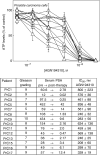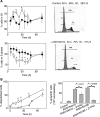An antagonist of retinoic acid receptors more effectively inhibits growth of human prostate cancer cells than normal prostate epithelium
- PMID: 15266311
- PMCID: PMC2409843
- DOI: 10.1038/sj.bjc.6602024
An antagonist of retinoic acid receptors more effectively inhibits growth of human prostate cancer cells than normal prostate epithelium
Abstract
Screening of synthetic retinoids for activity against prostate carcinoma cell lines has identified antagonists of retinoic acid receptors (RARs) as potent growth inhibitors (Hammond et al, 2001, Br J Cancer 85, 453-462). Here we report that 5 days of exposure to a high-affinity pan-RAR antagonist (AGN194310) abolished growth of prostate carcinoma cells from 14 out of 14 patients, with half-maximal inhibition between 200 and 800 nM. It had similar effects (at approximately 250 nM) on the prostate carcinoma lines LNCaP, DU-145 and PC-3. AGN194310 inhibited the growth of normal prostate epithelium cells less potently, by 50% at approximately 1 microM. The growth of tumour cells was also inhibited more than that of normal cells when RARbeta together with RARgamma, but not RARalpha alone, were antagonised. Treatment of LNCaP cells with AGN194310 arrested them in G1 of cell cycle within 12 h, with an accompanying rise in the level of p21(waf1). The cells underwent apoptosis within 3 days, as indicated by mitochondrial depolarisation, Annexin V binding and DNA fragmentation. Apoptosis was caspase-independent: caspases were neither cleaved nor activated, and DNA fragmentation was unaffected by the pan-caspase inhibitor Z-VAD-FMK. The ability of AGN 194310 to induce apoptosis of prostate cancer cells and its differential effect on malignant and normal prostate epithelial cells suggests that this compound may be useful in the treatment of prostate cancer.
Figures






Similar articles
-
Retinoic acid receptor γ is a therapeutically targetable driver of growth and survival in prostate cancer.Cancer Rep (Hoboken). 2020 Dec;3(6):e1284. doi: 10.1002/cnr2.1284. Epub 2020 Sep 3. Cancer Rep (Hoboken). 2020. PMID: 32881426 Free PMC article.
-
Antagonists of retinoic acid receptors (RARs) are potent growth inhibitors of prostate carcinoma cells.Br J Cancer. 2001 Aug 3;85(3):453-62. doi: 10.1054/bjoc.2001.1939. Br J Cancer. 2001. PMID: 11487280 Free PMC article.
-
A retinoid-related molecule that does not bind to classical retinoid receptors potently induces apoptosis in human prostate cancer cells through rapid caspase activation.Cancer Res. 2004 May 1;64(9):3302-12. doi: 10.1158/0008-5472.can-03-2763. Cancer Res. 2004. PMID: 15126374
-
The prospects of retinoids in the treatment of prostate cancer.Anticancer Drugs. 2002 Sep;13(8):781-90. doi: 10.1097/00001813-200209000-00001. Anticancer Drugs. 2002. PMID: 12394261 Review.
-
Antagonizing RARγ Drives Necroptosis of Cancer Stem Cells.Int J Mol Sci. 2022 Apr 27;23(9):4814. doi: 10.3390/ijms23094814. Int J Mol Sci. 2022. PMID: 35563205 Free PMC article. Review.
Cited by
-
Lessons to cancer from studies of leukemia and hematopoiesis.Front Cell Dev Biol. 2022 Sep 20;10:993915. doi: 10.3389/fcell.2022.993915. eCollection 2022. Front Cell Dev Biol. 2022. PMID: 36204679 Free PMC article. Review.
-
The RARγ Oncogene: An Achilles Heel for Some Cancers.Int J Mol Sci. 2021 Mar 31;22(7):3632. doi: 10.3390/ijms22073632. Int J Mol Sci. 2021. PMID: 33807298 Free PMC article. Review.
-
Retinoic acid receptor γ is a therapeutically targetable driver of growth and survival in prostate cancer.Cancer Rep (Hoboken). 2020 Dec;3(6):e1284. doi: 10.1002/cnr2.1284. Epub 2020 Sep 3. Cancer Rep (Hoboken). 2020. PMID: 32881426 Free PMC article.
-
From Propargylic Alcohols to Substituted Thiochromenes: gem-Disubstituent Effect in Intramolecular Alkyne Iodo/hydroarylation.J Org Chem. 2021 May 21;86(10):7078-7091. doi: 10.1021/acs.joc.1c00333. Epub 2021 Apr 30. J Org Chem. 2021. PMID: 33928778 Free PMC article.
-
Activation of RARα Receptor Attenuates Neuroinflammation After SAH via Promoting M1-to-M2 Phenotypic Polarization of Microglia and Regulating Mafb/Msr1/PI3K-Akt/NF-κB Pathway.Front Immunol. 2022 Feb 14;13:839796. doi: 10.3389/fimmu.2022.839796. eCollection 2022. Front Immunol. 2022. PMID: 35237277 Free PMC article.
References
-
- Altucci L, Gronemeyer H (2001) The promise of retinoids to fight against cancer. Nat Rev Cancer 1: 181–193 - PubMed
-
- Bunce CM, Wallington LA, Harrison P, Williams GR, Brown G (1995) Treatment of HL60 cells with various combinations of retinoids and 1α, 25 dihydroxyvitamin D3 results in differentiation towards neutrophils or monocytes or a failure to differentiate and apoptosis. Leukaemia 9: 410–418 - PubMed
-
- Campbell MJ, Park S, Uskokovic MR, Dawson MI, Koeffler HP (1998) Expression of the retinoic acid receptor-β sensitises prostate cancer cells to growth inhibition mediated by combinations of retinoids and 19-nor hexafluoride vitamin D3. Endocrinology 139: 1972–1979 - PubMed
-
- Chinni SR, Upadhyay S, Koppolu PK, Sarkar FH (2001) Indole-3-carbinol (I3C) induced growth inhibition, G1 cell cycle arrest and apoptosis in prostate cancer cells. Oncogene 20: 2927–2936 - PubMed
Publication types
MeSH terms
Substances
LinkOut - more resources
Full Text Sources
Other Literature Sources
Medical

